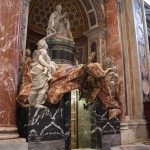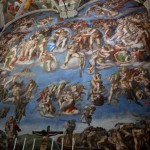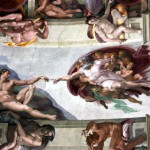The book of Job is about Job’s trials at the hands of Satan. Here is a paraphrased version of the story: Job is a pious man. Satan approaches God and says that Job is so pious mostly because God has kept him fairly well off. If God were to take away all of Job’s possessions, then Job would fail is his duties as a pious man. God accepts this challenge and takes all possessions away from Job. Despite this, Job remains pious. As his misfortunes pile up, Job finally caves in and questions God about this ‘injustice’. In response, God emphasizes his sovereignty in creating and maintaining the world. Finally, humbled by God’s chastising, Job turns speechless, giving up and repenting his previous requests of justice. To this, Job is restored to health, gaining double the riches he possessed before and having new children.
This is a typical story of a righteous sufferer. As you have probably guessed, there is a remarkably similar story in Markandeya Purana: the story of King Harishchandra. Similar to Job, King Harishchandra is an extremely righteous king who never goes back on his word and never lies. For various reasons (the reasons change with every retelling of the story) sage Vishwamitra, once approached Harishchandra and informed him of a promise made by the king to donate his entire kingdom. True to his word, Harishchandra did so. The sage, proclaimed that for an act of donation to be completed, an additional amount as Dakshina (honorarium) had to be paid. Harishchandra, with no money in his hands, had to sell his wife and son. Eventually, he had to sell himself to a guard at a cremation ground.
The king, his wife, and son endured tremendous hardships. Thanks to an unfortunate sequence of events, the son dies, and his wife brings the son’s body to the cremation ground for the last rites. She is so poor that she could not even pay the taxes needed to cremate him. Even though Harishchandra realizes that his son is dead, his wife is begging him to help perform the last rites, and he is overcome is grief, he does not waver from his dharma (duty). He asks for the sacred wedding necklace around his wife’s neck as payment of the tax. She willingly rests her head on a stone slab and asks Harishchandra to chop her head off for the necklace (the only way a woman may take her wedding necklace off while her husband is alive is in death). As he gets ready to chop her head the Gods appear and inform him that his righteousness was being tested. His son, wife, and kingdom is restored to him.
Theological import and motivations for these two myths aside, I am interested in how they came to be so similar. Like with the case of Orpheus and Adi Shankara, there are too many similar elements (riches to rags, death of progeny, survival of the spouse, and so on). So I wager that this is no coincidence.
Let us take a closer look at the earliest known dates for these myths. The earliest textual origins for the Book of Job is placed in 4th century BCE. Whereas, the origins of Markandeya Purana is unknown, the earliest known written form is placed in 3rd century CE. Naturally, it is entirely possible that the puranas were an established oral tradition prior to this date. Besides, this still doesn’t provide us with a connection between the two myths.
Disclaimer: what follows next is entirely my hypothesis without scholarly research. Feel free to debase and/or ignore my speculations.
Looking at the geography between the Middle East and India, we see that the Persian empire occupied most of the space. Interestingly, there is a long history of Judaism in Persia. The 4th century BCE (the period attributed to the written origins of the Book of Job) saw huge political turmoil in Persia thanks to Alexander the Great. His empire reached into the greater India region. Given that some anthropologists hypothesize that Alexander’s troops learned kissing from India and too it back to Greece. It is not at all inconceivable that the story of a righteous sufferer traveled between the Jews in Persia and the Vedic/proto-Hindu people in India.
The question that still remains is which way did it travel? From India to Persia, or the other way around? If anyone has any hypothesis, clues, arguments, I would love to hear them. As of now, my speculation stops here.
UPDATE: The Book of Job seems to have been pre-dated by an ancient Sumerian text “A man and his god“. This gives us a good idea of the direction in which the story may have travelled, but that doesn’t explain the how the exegeses travelled. I have a hard time believing that the Jews came up with it all on their own simply because there aren’t many philosophical treatises written by the ancient Jewish people. The Greek and Indians, on the other hand, were a whole another story. My bet is that the exposition and exegeses associated with the Book of Job either came from Greece with Alexander the Great, or the story first travelled to India, and the philosophers in India gave it the philosophical mortar and this travelled back the Persia via Alexander’s army and made it back to the Jewish people.
]]>Interestingly, there has been cross-pollination of stories between these two. I know of at least one instance where the ‘plagiarism’, if you will, is all too evident. The Indians plagiarized the Greek when telling a story from the life of Adi Shankaracharya. Specifically, the story of Adi Shakaracharya and Kollur Mookambika has been ripped off from the story of Orpheus and Eurydice.
Let us start with the story of Adi Shankar and Mookambika. The following has been quoted from the wikipedia article on the subject, dated Aug. 31, 2010:
It is believed that Adi Shankaracharya had a vision of Sri Mookambika Devi and installed the deity here. The legend goes that Adi Shankara mediated at Kodachadri hills and Devi incarnated before him asking for his wish. He revealed his wish to install the Devi idol in a place in Kerala to worship where he wanted. Devi agreed but put forward a challenge that she will follow Shankara and he should not look back till he reaches his destination. But to test Shankara, Devi deliberately stopped the voice of her anklets when they reached Kollur whereupon Shankara turned and looked back because of doubt. Devi then asked Shankara to install her vigraha, just as he sees her, at that very location in Kollur.
Here is Virgil‘s account of Orpheus and Eurydice copied from (again) the wikipedia article on the subject, dated Aug. 31, 2010:
The most famous story in which Orpheus figures is that of his wife Eurydice (also known as Agriope). While walking among her people, the Cicones, in tall grass at her wedding, Eurydice ran into a nest of snakes which bit her fatally on her heel. Distraught, Orpheus played such sad songs and sang so mournfully that all the nymphs and gods wept. On their advice, Orpheus traveled to the underworld and by his music softened the hearts of Hades and Persephone (he was the only person ever to do so), who agreed to allow Eurydice to return with him to earth on one condition: he should walk in front of her and not look back until they both had reached the upper world. He set off with Eurydice following and in his anxiety as soon as he reached the upper world he turned to look at her, forgetting that both needed to be in the upper world, and she vanished for the second time, but now forever.
Now, who copied who? As it turns out Virgil lived in 1st century BCE whereas Adi Shakaracharya lived in 9th century CE. You do the math.
I love mythologies and the many dots you can connect with it.
]]>After reading this exposition on the issue by Great Bong. I realized that if Park51 were actually an effort by terror-loving organizations, then it’s a master stroke indeed! I find it hard to believe that Soho Properties did not foresee any issues or controversies with announcing a major construction project to benefit Muslims so close to Ground Zero. Knowing the tea baggers, Fox News, Sarah Palin, and their ilk. It is preposterous to claim innocence to not having anticipated such a backlash. So what forced them to proceed ahead with the plan?
Consider this: let some radical Islamic terrorist organization X want to indulge in a negative PR campaign against the US. Specifically, create a propaganda that depicts US as an intolerant nation, thereby denying US its moral high-ground in the so called “war on terror”. All X has to do is create a political catch-22 situation for US by capitalizing on the severely polarized political atmosphere near an election season. The Park51 fits the bill perfectly. The Right and the republican party simply plays into X’s ploy and is vituperative in its opposition to the construction despite having no constitutional or legal basis for doing so, whereas the Left and Libertarians play their part by opposing the Right. The catch-22 here is that if Park51 does not come through, the the US is demonstrated as a bigoted nation with none of the freedoms that it is putatively defending through its “war on terror”: bad PR. On the other hand, if Park51 does come through, then Islamic organizations like X can claim victory in Islamization of the US (again potentially bad PR if not handled well), which will further enrage the Right to act Islamophobic (definitely bad PR!).
So are the entities responsible for Park51 unfortunate victims of the far Right’s bigotry? It is entirely possible. But are we sure that there not more than what meets the eye here? That’s something to think about.
P.S.: Even if my conspiracy theory was true, IMHO pulling the curtains on Park51 is a far worse proposition then letting it go through and then engaging in a careful discourse and PR campaign to mitigate the damage from the far Right’s Islamophobia.
]]>]]>
One is forced to wonder: why is Pat Robertson saying such things knowing fully well that he is hurting people through his statements and hate? There has to be a logical explanation for it, and I think I have found one. My explanation is based on three important assumptions: (a) Pat Robertson believes that Jesus died for everyone’s sins, (b) he believes that the end times is near [1], and (c) he is a capitalist[2].
Now, given that Pat Robertson is a capitalist, he must believe that the capitalist economic principles can be applied everything in life, including sin. So according to him, there must be some smallest unit of sin (arguably the smallest unit corresponds to the quality of sin in the ‘original sin‘), and also that Jesus’s death is worth only so many (finite) units of sin. Given that the end times are around the corner — being a shrewd capitalist one needs to get the best ‘bang for the buck’, so to speak — Pat Robertson probably wants to make Jesus’s death more worthwhile by sinning as much as he can so that the quota of sins for which Jesus died may be used up.
After all, every ‘true’ Christian’s goal is to make Jesus’s death worthwhile (in that Jesus’s death should not be in vain). So, it turns out that Pat Robertson is actually out sinning to make Jesus’s death count for something! Now he also knows that you sin then you will probably go to hell, and yet he pursues this path of validate Jesus’s crucifixion. Could there possibly be a greater sacrifice?
[1]In fact, in the 70s Pat Robertson has predicted that the world would end in 1982!
[2]This is more of an inference, than an assumption, based on the fact that Pat Robertson is a businessman, owns a broadcasting station, and sells books for money.
]]>The story of King Mahabali
Mahabali was the king of asuras (who are a class of deites, and not demons; demons are called rakshasas in Hindu mythology). The asuras ruled in Paatala loka (which is one of the 14 worlds, and is not hell; hell is called Narka in Hindu mythology). Mahabali expanded his empire to all the 7 ‘lower’ worlds and then invaded Bhuloka (or the earthly world): the lowest of the 7 ‘higher’ worlds. Then he set his eyes on the remaining ‘higher’ worlds which were ruled by devas (another class of deities). The king of devas, Indra, was worried by this expansion and realized that he was no match for Mahabali, so he approached lord Vishnu to save his kingdom. Vishnu then took the form of vamana, or a brahmin boy, and approached Mahabali for Daana or donation/alms. Vamana asked for three steps of land for him to live in. Mahabali agreed. Then Vamana grew so large that in one step he covered all of the higher worlds, and in another step he covered the Bhuloka, and asked Mahabali where he should place his third step. Realizing that he has been bested, Mahabali asked the third step to be put on his head and Vishnu placed his third step on Mahabali’s head sending him to Paatala.
The story of Ramayana (hopelessly abridged)
Prince Rama is sent on an exile with his wife and brother. They wander to south of Vindhya mountains and down south, king Ravana of Lanka abducts Rama’s wife. While searching for his wife he comes across a kingdom of monkeys (vanaras) and with their help he defeats Ravana and rescues his wife.
Obvious connections
So how do these stories point to Aryans and Dravidians? The most obvious references here are (a)the notion of Mahabali being from the ‘lower’ world (possibly refering to south India) and the devas and Vishnu being from the ‘higher’ workd (possibly refering to north India, and (b) Rama being an Arya putra from Ayodhya (in north India) and Ravana being from Lanka (in the south) and the Dravidian people being referred to as ‘monkeys’.
But we need more than such annotated instrumentation to make our case.
Mahabali and Onam
First, lets look at the case of Mahabali. King Mahabali is said to been a very just king and all of his subjects were said to have lived properously during his reign. Yet he is cast down back to Paatala. Also, Paatala could well refer to the state of Kerala (again, in the south) because the Hindu festival of Onam celerbrated only in Kerala is a celebration of King Mahabali, their King Mahabali. It is worth noting that Hindus in Kerala celebrate the reign of an asura king who was cast down by Vishnu and interestingly, such a celebration is endemic to Kerala. It is not celebrated anywhere else!
Vijayadashami in north and south India
In north India the Hindu festival of Vijayadashami marks the defeat of Ravana by Rama. However, in south India, the same festival marks the defeat of Mahishaura by Durga. Why such different reasons to mark the same festival? The only bridge between the two is the tale that Rama performed a sacrifice to Durga in the eve of the battle with Ravana. This suggests that these were really two different festivals in two different cultures and religions. They were later joined together by expansion of Hinduism into all of India.
The legend of Vindhya and Agasthya
The legend is that Vindhya mountains (which separates north and south India) started growing to such heights that it challenged the path of sun in the sky. So sage Agastya, in order to stop this growth asked Vindhyas to stoop down so that he may cross to down south. He also extracted a promise that Vindhyas would not grow any higher until he returned back north. But Agastya permanently settled in the south, and so the Vindhyas did not grow anymore.
The story (which is from the puranas, and is said to have occured before the itihaasas) can be interpreted as the northerners’ (Aryans) conquest over the Vindhyas (much like the conquest of Mt. Everest) which paved way for migration to south India, thus triggering contact with the south Indian Dravidians.
Genetic Markers, Caste System, and the North-South Divide
A recently published study of genetic profiles of Indian peoples concludes a distinct divide among Ancestral North Indian (ANI) tribes and Ancestral South Indian (ASI) tribes with very strong evidence of enogamy. The study also revealed that individuals descending from the ANI tribes tend to be in the ‘higher castes’ and are genetically closer to europeans where as individuals descending from the ASI tribes tend to be in the ‘lower castes’. This again points to an Aryan-Dravidian divide that has been there for millenia, and the strong enogamy suggests conflict and competition between the groups, and looks like the Aryans won the struggle and encoded it into their mythology which was then shared with the Dravidians when they all became a single Hindu people, yet isolated from each other by caste barriers.
]]>
The pope said that evolution is ok by him. So I guess that means that the Catholics can down become evolutionary biologists/anthropologists and such. I wonder what happened in 150 years that changed Vatican’s mind? Given that Catholics assume that Pope has God’s mandate over Christiandom, Pope must have been talking to god on a fairly regular basis. My best guess is that the Pope got a call from God and it went something like this:
“Hey Benedict! Wassaap? Its your old man here. Howz my favorite catholic doin’?…”
“Oh yeah, by the way, Darwin and I had a long chat some time back. He’s a really nice fella. He’s got an awesome beard too. Nothing like mine, but hey, gotta give props where its due right? Anywayz, so Darwin and I were chillin’ out smoking some reefer and stuff… hey, now don’t be judging, I created it remember? So yeah, I realized Darwin’s a cool dude after all. We play checkers all the time now. He’s awesome, he always let me win! So I’ve decided to let him into heaven….”
“What’s that? Oh, the evolution thing? Yeah… well… tell ya what, we are still vetting Einstein to be let into heaven. All the Democratic angels want him in, but the Republican angels are giving him a tough time, with he being a Jew and not believing in my Son and all, but we’ll get there….”
“Why Einstein? Dude! I am sick and tired of there harps all over the place, I need something different, and Einstein’s awesome on the violin. Anywayz, coming back, here’s what you can do, you can tell everyone that evolution is now cool with Me, and that the whole creating the universe in 7 days.. well Einstein here tells me that if I said that I was going at the speed of light when I created the universe, then somehow my watch slows down, and so my 7 days is really billions of years on earth. And that fits nicely with evolution and everything….”
“What?! Me come down and say that myself? The last time I tried doing something like that they nailed my Son to a tree! No way pal! Fool me once shame on you, fool me twice shame on me!…”
“Look, I know its not going to be easy convincing everyone, but hey, its not the first time! Remember Galileo? Yeah, we managed to get people to be cool with him after 300 years, and this is just half that time. It’ll work out Benedict… tell ya what, you do this for me and I’ll throw in a couple of extra virgins when you get here. How about that?…”
“Sweet! Gotta go pal. The whole global warming crap that people are into is keepin’ me busy.. I got a few more hurricanes to create in the Atlantic, and yeah, I was tardy on the whole ice-sheet melting thing. Apparently it wasn’t as drastic as last year. Gotta make up for that! Jeez, I need a vacation! Anywayz, gotta go, ciao.”
Image source: http://www.markvernon.com/friendshiponline/images/Jesus&Darwin.jpg
]]>They displayed a world map which marked all the countries which were ‘hostile’ to Christianity. The interesting thing about the maps was the color coding they used. All the countries which do not recognize Christianity as a religion were color mellow yellow. These were countries like Pakistan, Saudi Arabia, China, countries in Africa etc. But countries like India and Turkey, which upload the freedom of religion were marked bright blood red as ‘hostile’ regions!
It was a clever game they were playing. It is obvious that there is little you can do to promote Christianity in countries whose political atmosphere restricts them, hence a mellow yellow. However in secular countries like India and Turkey, you have the right to practice and preach Christianity. and of course, there will always be fundamentalist elements in the society who indulge in violence against religions they do not approve personally (e.g., Graham Stains murder in Orissa, India). In such secular countries, you have been sanctioned the right to convert as many as you can to your religion. So, Bryan House of Prayer decided bring people’s attention to such countries with the bright red.
Come to think of it, I dont think there is any religion in India whose fundamentalists will claim that India is a safe house for them. The Hindus cry foul over the political parties appeasing the Muslims, Muslims cite Babri Masjid, Christians cite Graham Stains, and so on. However, we have so many Christian missionaries, churches, schools, convents etc. in India, all of which are working without any persecution. In fact a lot of Hindu parents send their kids to Christian schools!
Coming back, the lady at the Bryan House of Prayer booth goes on to say “Did you know over 300,000 Christians are killed every year for their beliefs? In the US today, they merely mock us, but soon they will come for us. They will persecute us for our beliefs.”
What’s with this maniacal desperation to be persecuted for being a Christian?!? I thought Christianity was a religion of peace, not masochism!!
]]>Halloween is the Christianized bastardization of the wonderful Celtic harvest festival called Samhain. One of the more relatively recent bastardization is called ‘Trick-or-treating’ (it started circa 1930s). Trick-or-treating typically involves children going from house to house asking for candy with the question ‘Trick or treat?’ (Leaving all the pedophiles salivating in the process). The ‘treat’ part being a ritualized begging for candy, and the ‘trick’ part referring to the threat of playing a trick on the owner of house, or on the property itself.
So yeah, we have trick-or-treating during Halloween. There is a name for this whole process of asking for candy or threatening with not-so-pleasant consequences – back where I come from, its called Extortion.
Coming back to my original claim, have you noticed how US likes to talk to other nations? — “Give us your oil, or we’ll invade you country under a false pretext”, “Surrender you nuclear technology to us, only we should have nuclear weapons, not you. Or else, we’ll impose sanctions on you”, “Remove your subsidies agriculture (but we’ll keep ours) so that we can dump our surplus in your market, or else we will ban import of your goods into the US”, and so on.
I don’t know about you, but that sounds a lot like trick-or-treat to me! Like I said, Bush, Cheny,and co. must have loved trick-or-treating during Halloween, coz’ they are doing it with the rest of the world today; only this time thousands end up dying for their (Bush and Cheny’s) amusement.
]]>(Having said that, I still recommend people seeing this movie. The attempt and effort is legitimate. So are a lot of fears expressed in it.)
Virgin Birth
My opinion of the movie received its first dent when, in Part I, it says that Krishna (a Hindu god) was born of a virgin. I may not know about Greek, Roman, or Egyptian mythology, but I do know Hindu mythology and I know for a fact that Krishna is not believed to be of virgin birth. This gives me good reason to suspect the claims about the stories of Horus, or Dionysus, or any other mythical character that the movie talks about.
Authority of Sources
Going back to the source of this ‘information’ in the sources page, I found that the Krishan’s Virgin Birth assertion was obtained from books by M.D. Murdock (a.k.a Acharya S.). Acharya is a major proponent of the Jesus myth hypothesis, but her works cite other works that are of suspect authority, and provides extremely once sides citations. In fact, most of the sources and books cited in the movie website are all in the style of conspiracy theories, and have suspect authority at best. By the principle of inheritance of authority, Zeitgeist is of questionable authority as well.
What is plausible may not be true
Zeitgeist shows what could be a plausible explanation for Christianity, 9/11, and the federal reserve system, but they need not be true. To assert the truth of any statement, one needs to (a) show that the statement cannot be falsified, and (b) all other statements that oppose this statement can be falsified. Zeitgeist fails on both counts, and hence cannot assume credibility to the statements it makes.
Obfuscation Through Over-Simplification
Specifically in Part III, the description of money generation by the Federal Reserve Bank is over-simplified to a point where its practically untrue. The pathological sequence of events that could lead to a financial catastrophe is true, but the described mechanism of the Federal Reserve Bank fueling massive debts on America is not. A good place to get an idea of how money is generated is the Money Creation article on wikipedia.
Also, as far as massive debts due to interests on loans that serve to feed more loans and so on, go.. well… that’s pretty much how any economy runs. The money has to come from somewhere, and this ‘generation’ of money has to be controlled (to avoid ‘over heating’ the economy and spiraling the inflation), the best means of doing so is to attach a penalty to generating money, and that’s what the Federal Reserve accomplishes by charging interest on the money thats generated.
So that’s my 2 cents worth second thoughts on Zeitgeist. However, I still encourage people to see this movie. At the very least, to see what alternate explanations can be provided for a same facts presented to you. All too often you have access only to the media’s interpretation events and facts. This is great way to see the counterculture argument and interpretations.
]]>















